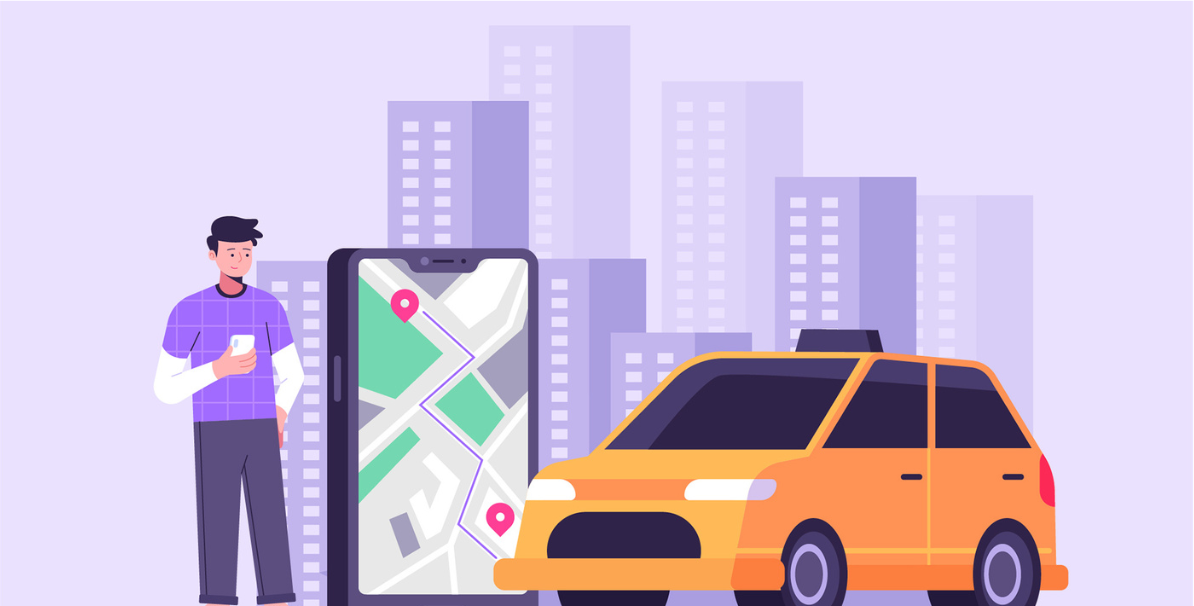In recent years, on-demand ride-hailing apps like Uber have revolutionized the transportation industry, providing convenient and efficient ways for people to book rides. Whether you’re an entrepreneur looking to tap into this lucrative market or a business owner seeking to enhance your services, building an app like Uber can be a promising venture. This article explores the essential steps and considerations involved in creating your own ride-hailing app.
What are the 3 pillars of creating an app like Uber?
If you are looking to develop a taxi booking app similar to Uber, you need to focus on three fundamental components: The Passenger App, The Driver App, and The Admin App.
Passenger App
The Passenger App stands as the central hub for those seeking rides that ensure a positive and straightforward user experience. Key features of the passenger app encompass:
Registration and Profile Management: This feature simplifies onboarding with a swift and secure registration. Users can effortlessly create profiles, add payment methods and set preferences.
Real-Time Tracking: This particular feature utilizes GPS technology for instant ride tracking, enhancing safety and overall user experience.
Payment Integration: This provides various payment options, including credit/debit cards, digital wallets, and local payment methods, maintaining transparency and security in transactions.
Rating and Feedback System: It implements a dual rating system, allowing passengers and drivers to provide feedback for continuous service quality improvement.
Notifications: It keeps users informed through timely updates on ride status, driver details, and promotional offers.
Driver App
The Driver App serves as the nerve center for those behind the wheel. It is designed to empower drivers and ensure efficient navigation. The key features of the driver app includes:
Simple Onboarding: Streamlines the driver registration process, ensuring quick verification and approval with a clear interface for document submission.
Navigation and Route Optimization: Integrates a robust navigation system for quick route finding. Route optimization algorithms enhance efficiency to reduce travel time.
Earnings Dashboard: Offers a transparent earnings dashboard displaying trip details, earnings, and incentives. Clarity on income contributes to driver satisfaction and retention.
Communication Tools: Implements in-app communication tools, such as messaging or call features, facilitating communication between drivers and passengers.
Driver Ratings and Feedback: This enables drivers to view their ratings and feedback, fostering a continuous improvement mindset.
Admin App
The Admin App functions as the control center, overseeing the entire operation. It plays a crucial role in maintaining the integrity and efficiency of the platform. Key features of the Admin app are as follows:
User and Driver Management: It allows administrators to manage user accounts, driver profiles, and conduct necessary verifications.
Monitoring and Analytics: Implements tools for real-time monitoring of rides to ensure compliance with safety standards. Analytics features provide insights into user behavior, aiding strategic decision-making.
Dynamic Pricing Control: It helps administrators adjust pricing based on demand, ensuring a balance between supply and demand during peak times.
Emergency Response System: Integrates an emergency response system to handle critical situations swiftly and efficiently, ensuring the safety of both passengers and drivers.
System Updates and Maintenance: Facilitates seamless updates and maintenance to keep the platform secure, efficient, and up-to-date with the latest technological advancements.
Must have Uber features for any taxi app development
Creating a successful taxi app requires incorporating essential features that contribute to a seamless user experience, driver efficiency, and overall business functionality. Here’s a guide to must-have Uber features for any taxi app development.
User-Friendly Registration and Profile Management
One crucial aspect is ensuring a user-friendly registration and profile management system, facilitating a quick account creation process, and allowing users to effortlessly manage profiles and payment details.
Real-Time GPS Tracking
Accurate real-time GPS tracking is fundamental, requiring the integration of GPS technology for precise location tracking of both users and drivers. Utilizing mapping APIs enhances the real-time navigation experience, optimizing routes for efficiency.
In-App Messaging and Notifications
In-app messaging and notifications play a vital role in user-driver communication. Implementing features such as ride confirmations and driver arrival notifications enhances the overall user experience by keeping users informed and engaged throughout their journey.
Transparent Fare Calculation
Transparent fare calculation is a key element, involving the development of a dynamic system based on distance, time, and other relevant factors. Providing fare estimates before confirming rides contributes to user trust and satisfaction.
Multiple Payment Options
Multiple payment options should be integrated to offer users flexibility. A secure and diverse payment gateway accommodating credit cards, digital wallets, and other region-specific methods ensures a seamless transaction experience.
Driver Tracking and Management
Efficient driver tracking and management are essential components. A comprehensive dashboard for drivers facilitates the management of ride requests, navigation, and earnings. Implementing a user-driven rating system ensures service quality and reliability.
Ride History and Receipts
Offering users access to ride history and detailed receipts enhances transparency and user confidence. Information such as the route taken, distance, fare breakdown, and payment method contributes to a well-informed user experience.
Safety Features
Safety features are critical, incorporating an emergency button for users and drivers, along with thorough driver background checks. Allowing users to share trip details with contacts adds an extra layer of security.
Surge Pricing and Promotions
Surge pricing during peak hours helps balance supply and demand, ensuring the availability of drivers when needed. Implementing promotional campaigns and discounts attracts and retains users, contributing to the app’s success.
Review and Rating System
A robust review and rating system is fundamental for maintaining service quality. Users should be able to provide feedback and rate drivers after each ride, enabling continuous improvement and user satisfaction.
Multi-Language Support
Multi-language support is crucial for catering to a diverse user base. Offering language options allows users to choose their preferred language, enhancing accessibility and usability.
Admin Dashboard
An admin dashboard is essential for centralized management, enabling administrators to oversee users, drivers, and transactions. Analytics tools should be integrated to monitor key performance indicators and inform data-driven decisions for continuous improvement.
Referral Program
Introducing a referral program incentivizes users to invite others, contributing to user acquisition and retention. Rewards such as discounts or credits for successful referrals enhance user engagement and satisfaction.
Advanced Analytics and Reporting
Advanced analytics and reporting tools are crucial for gaining insights into user behavior, popular routes, and overall app performance. Utilizing data-driven insights informs strategic decision-making and fosters continuous improvement.
Legal and Regulatory Compliance
Legal and regulatory compliance is a foundational aspect, necessitating awareness and adherence to local transportation regulations. Obtaining necessary licenses and approvals ensures lawful operation in specific regions.
By incorporating these must-have features, a taxi app can provide a comprehensive and reliable service, ensuring a positive experience for both users and drivers while adhering to industry standards and regulations.
Tech Stacks to consider for uber like app development
Creating an Uber-like app involves careful consideration of the technology stack to ensure optimal performance, scalability, and user satisfaction. Here’s a guide to the key tech stacks to contemplate for successful taxi booking app development.
Frontend Development
Cross-Platform Frameworks: React Native or Flutter
Responsive Design: CSS frameworks like Bootstrap or Tailwind CSS
Backend Development
Server-side Technologies: Node.js, Python (Django or Flask), Ruby on Rails
Database Management: PostgreSQL, MongoDB
API Integration: Google Maps API, Mapbox API, Stripe, Braintree
Cloud Services
Cloud Computing: AWS, Google Cloud, Microsoft Azure
Real-Time Features
WebSockets: Socket. io, SockJS
Geospatial Technology
Geospatial Databases: PostGIS
Security Measures
Data Encryption: SSL/TLS for data in transit, bcrypt for password hashing
DevOps Tools
Continuous Integration and Deployment (CI/CD): Jenkins, GitLab CI
Monitoring and Analytics
Analytics Tools: Google Analytics, Mixpanel
Cross-Platform Communication
Message Brokers: RabbitMQ, Apache Kafka
How can GML Soft Labs help you develop an Uber-like app?
At GML Soft Labs, we offer our expertise in creating user-friendly apps with all the necessary features, just like Uber’s app. Our team comprises experts who work closely with you to understand your requirements and provide customised solutions that align with your business needs.
We use the latest technology to ensure that your app is not only excellent but also secure and safe to use. Throughout the process, our team keeps you informed and takes your feedback to make sure that the app is precisely the way you want it to be. Even after the app is up and running, we remain available to assist you with any issues and keep it updated to ensure seamless performance.
Conclusion
GML Soft Labs stands out as the best app development company in Chennai, When you choose us, you’re not only getting an app but a team that is dedicated to your success and committed to making your ride-sharing app a hit. Let’s turn your ideas into a fantastic app that your users will love to use, and Contact us today.
FAQs
How much does it cost to develop an app like Uber?
The cost of developing an app like Uber varies depending on factors such as features, technology stack, and development approach. A rough estimate can range from tens of thousands to millions of dollars.
What are the legal considerations when building a ride-hailing app?
Legal considerations include compliance with transportation laws, licensing requirements, data protection regulations, and liability issues. It’s essential to consult legal experts to ensure compliance with local regulations.
How can I attract users to my ride-hailing app?
You can attract users through effective marketing strategies such as social media promotion, influencer partnerships, referral programs, and offering incentives like discounts or free rides.
What are some common challenges faced in the ride-hailing industry?
Common challenges include driver retention, ensuring passenger safety, regulatory hurdles, competition from established players, and maintaining profitability amid fluctuating demand and operating costs.
What are some future trends shaping the ride-hailing industry?
Future trends include the rise of autonomous vehicles, adoption of electric mobility, integration with other services like food delivery or logistics, and the emergence of new business models like mobility-as-a-service (MaaS).
 seolounge
seolounge
